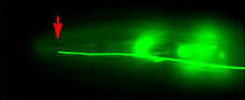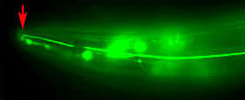Neurobiologists identify an essential protein for axon regrowth in animal model
September 2, 2009
By Susan Brown

In normal worms, the "touch" neuron stops short of the worm's nose.

But in mutant worms the neuron overshoots its normal target, often wandering in a loop, like a lost hiker
Neurobiologists working with Yishi Jin at UC San Diego have shown that a protein called DLK-1 helps axons find their way and form proper connections once they reach the correct destination. DLK-1 works through a short chain of chemical signals that preserve the recipe for a particular protein. Jin and Andrew Chisholm, both biology professors at UC San Diego, and their co-authors report their finding this week in the journal Cell.
The same system is also required for injured axons to regrow, they found. They study a roundworm called C. elegans, which readily regenerates damaged nerves. But severed axons wither away in mutant worms that are missing parts of the DLK-1 system. Restoring the system helps the axon regrow. Mutant worms appear normal and respond to touch and lay eggs like worms without genetic defects. "Nature has reserved a whole set of genes that are not essential to building an organism but that are essential for the repair process," Jin said.
That doesn't mean those genes are infrequently used, Chisholm cautioned. Lab worms are coddled, he points out, and worms may have a more constant need for repair when living in their native habitat, outdoor soil.
Jin is a Howard Hughes Medical Institute Investigator and co-authors Dong Yan and Zilu Wu are both Howard Hughes Medical Institute Associates. Grants from the National Institutes of Health to Jin and Chisholm funded this research.
Comment: Media Contact:- Susan Brown 858.246.0161
